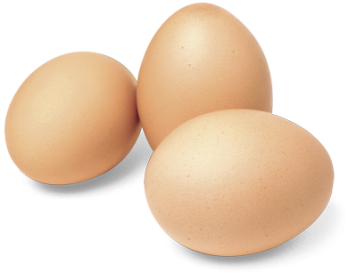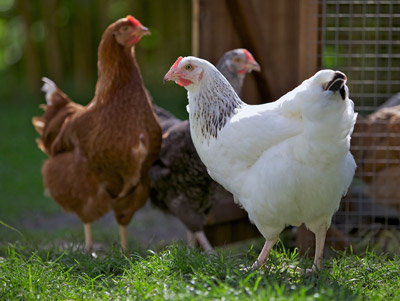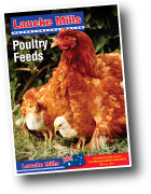Laucke Mills Poultry Range
Laucke Mills produce a range of quality poultry feeds to fulfil the nutritional requirements of all types of poultry. Our feeds are manufactured in various forms including pellets, crumbles, mash and grain mixes.

Feeding & Management Hints
FEED WASTAGE
Feed wastage can be a costly problem. To reduce feed wastage it is recommended that a feeder be used that prohibits the hens from scratching feed onto the ground. Also, hens will often tend to flick feed out of the feeder with their beak, to reduce this problem raise the height of the feeder to about head height. Position the feeder as high as possible but still allow easy access.
Due to the natural texture of Red Hen grain mixes birds will tend to eat the most attractive portions first and leave the least attractive until last. If self feeders are used it is not uncommon for birds to empty the feeder chasing the most desirable portion. To stop this messy habit it is recommended that grain mixes be fed on a daily basis and the birds made to eat the majority of the daily ration before replenishing the feeders.
HOUSING
Hens should be kept in a clean, dry, draught free hen house, preferably with an outside run. Protection from the elements and a comfortable environment are important for overall health and egg production.
Due to a hen’s preference to roost at night it is recommended that the hen-house be fitted with perches. Nesting boxes lined with a suitable material such as straw or shell grit should be provided so that eggs can be kept clean and dry.
PARASITES
Check hens regularly for parasites such as lice and mites, and if detected treat accordingly.
A number of treatments should be available from your local fodder or produce store.
 Fresh Household Food Scraps and Grass
Fresh Household Food Scraps and Grass
Hens will enjoy eating fresh household food scraps, grass and lawn clippings but it may be necessary to restrict access to these in order to prevent nutritional imbalances. Access to green grass which contains natural colouring pigments will enhance egg yolk colour and produce a rich and attractive yolk
Balanced Protein
Protein is an essential nutrient that is required by poultry for growth and egg production, but all protein is not the same. The protein level of a food can be a misleading indicator of how well that food will perform its intended job as the quality of the protein can vary a great deal. Protein is made up of amino acids which need to be in the correct ratio to each other (balanced) if the protein is to be fully utilised. The main amino acids that need to be supplied in a diet for laying or growing poultry at the correct balance are methionine, cystine, lysine, threonine, tryptophan and isoleucine. If any of these amino acids are in short supply the performance of the food will be limited.
In fact, it is likely that an unbalanced 20% protein diet will not perform as well as a balanced 15% diet if any of the essential amino acids are below requirements.
 Moulting & Day Length
Moulting & Day Length
Laying hens have a natural response to day length that affects the number of eggs laid. During autumn and early winter, when days are getting shorter, hens will tend to lay fewer eggs or may stop laying altogether and go into a moult.
A moult is a naturally occurring cycle that all hens go through a number of times during their life. During a moult a hen will stop laying, shed a large amount of its old feathers and replace them with new feathers. When the moult has finished the hen will start a new cycle of lay. This is why egg production is normally greater during spring.
This natural cycle can be altered by creating a constant day length. By lighting the hen house to create a constant “day length” (approximately 16 hours) it is possible to prevent hens from decreasing their production during autumn and winter. A simple household timer can be used to turn the lights on and off automatically.

